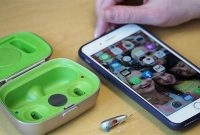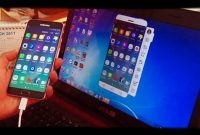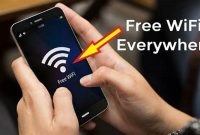If you’re like most people, you rely on your smartphone for everything from staying connected with friends and family to managing your daily schedule. Whether you’re using an iPhone or an Android device, linking your phone to other devices can sometimes be a hassle. Fortunately, there are some simple steps you can follow to make the process easier. In this article, we’ll take a closer look at how you can link your phone with minimal fuss.

What is Phone Linking?
Phone linking is the process of connecting your phone to another device to transfer data, make calls, or access features like music playback or navigation. Linking your phone to another device can be hassle-free if you know the steps to follow.
Connecting Your Phone to Another Device
To link your phone to another device, you need to follow these simple steps:
- Check if your phone is compatible with the device you want to link it to. You can do this by checking the device’s user manual or website.
- Turn on the device you want to link your phone to. Make sure the device is within range of your phone.
- On your phone, go to “Settings” and turn on Bluetooth. Your phone will automatically start searching for nearby devices to link to. If your device is not Bluetooth enabled, you can use a USB cable to connect the two devices.
- Select the device you want to link your phone to. You may be prompted to enter a password, PIN, or passcode to complete the linking process. If you’re linking to a car or audio system, you may be asked to enter a code that appears on the device’s screen.
- Once you have entered the password or code, the two devices will be linked. You can now transfer data, make calls, or access features on your phone through the linked device.
By following these simple steps, you can easily link your phone to another device. If you encounter any issues during the linking process, consult the device’s user manual or contact customer support for assistance.
Why Should I Link My Phone?
Linking your phone to other devices has become very common in recent years, with many people integrating smartphones into their daily routines. If done in the right way, it can provide tremendous convenience and ease of use for the user, as well as provide better functionalities over all. By linking your phone to other devices, you can access important features, transfer data quickly, and even use your phone as a remote control. Here’s why you should consider linking your phone today:
Better accessibility to important features
If you’re someone who is always on the move, linking your smartphone to other devices such as a smartwatch can help you stay on top of things easily. You’ll be able to view your messages, answer phone calls, check your calendar, and more without needing to pick up your phone every time. It can also be very convenient, especially when you cannot access your phone quickly, by simply asking Siri or Google Assistant to take care of tasks while you are busy doing other things such as cooking or driving.
Transfer data quickly and easily
Connecting your phone to other devices can make it much easier to transfer data such as images, files, and other documents between different platforms. For example, transferring images from your phone to your computer becomes hassle-free by quickly linking your phone to your computer. You can also connect to cloud services like Dropbox and Google Drive where files can be accessed from both the phone and computer without a physical connection. This has proven useful for people who work on the go, have multiple devices, or have a habit of misplacing devices.
Use your phone as a remote control
With advancements in technology, many appliances and devices now come with an option to be controlled by your smartphone, such as smart TVs, ACs, and speakers. Being able to use your phone as a remote control is the ultimate convenience, as it eliminates the hassle of having to go through several remotes and buttons. You’ll be able to turn off the TV after watching a movie by simply grabbing your phone from the couch and pressing the “power off” option on the screen. This feature has made daily life a lot easier in households by removing many frustrating time-consuming chores.
What Devices Can I Link My Phone To?
Have you ever found yourself wanting to connect your phone with another device but not quite sure if it’s possible? Well, we have some good news for you! You can link your phone to a variety of devices, including laptops, tablets, smart TVs, cars, and even some appliances.
1. Laptops and Tablets
If you frequently work on your laptop or tablet, it can be beneficial to link your phone to these devices. Doing so can help you transfer files quickly and easily, as well as receive notifications on your laptop or tablet. Additionally, linking your devices can allow you to control your laptop or tablet through your phone, which can come in handy if you need to make a presentation or start a video call.
2. Smart TVs
If you have a smart TV, you can link your phone to it to stream content directly on your TV. This is particularly useful if you want to watch a video or show that’s only available on your phone but want to view it on a bigger screen. Additionally, some smart TVs allow you to control your TV through your phone, so you don’t have to worry about losing your remote.
3. Cars
Have you ever wanted to play music or take a call while driving? Well, if you link your phone to your car, you can do just that. Most modern cars come equipped with Bluetooth capabilities, which means you can connect your phone to your car’s sound system and take hands-free phone calls or play your favorite tunes through your car’s speakers. This is not only convenient but also safer since you don’t have to take your eyes off the road.
If you have an older car that doesn’t come with Bluetooth, don’t worry! You can purchase an adapter that will allow you to connect your phone to your car’s sound system via an Aux cable.
The Bottom Line
Linking your phone to other devices can make your life easier and more convenient. With so many options available, you’re sure to find a device that suits your needs. So go ahead and try it out, who knows, you might discover a new way to make your life simpler!
What Are the Steps to Link My Phone?
If you’re struggling to connect your phone to your device via Bluetooth or Wi-Fi, we’ve got you covered. Here are the steps:
Step 1: Enable Bluetooth or Wi-Fi
The first step in linking your phone to another device is to enable Bluetooth or Wi-Fi on your phone. Depending on your phone’s operating system, the steps to enable these settings may vary. Here’s how to do it:
- For Android: Swipe down from the top of your screen to access the quick settings panel. Tap the Bluetooth or Wi-Fi icon to turn it on.
- For iOS: Go to Settings > Bluetooth or Settings > Wi-Fi, and toggle the switch to turn it on.
Step 2: Search for Compatible Devices
Once you’ve enabled Bluetooth or Wi-Fi, your phone will start scanning for compatible devices to connect to. If you are linking your phone to another phone, tablet, or computer, make sure that the device you want to connect to has its Bluetooth or Wi-Fi turned on as well.
Step 3: Establish a Connection
Once your phone has discovered the compatible device, select it from the list of available devices to initiate the connection process. The device you are linking to may prompt you to enter a passcode or code to establish a secure connection. Follow the on-screen instructions to complete the process.
Step 4: Troubleshooting
If you’re still having trouble connecting your phone to another device, try the following troubleshooting tips:
| Problem | Solution |
|---|---|
| Unable to find compatible device | Make sure the device you want to connect to is in pairing mode and its Bluetooth or Wi-Fi is turned on. Also, ensure that your device is within range of the compatible device. |
| Connection keeps dropping | Try resetting the Bluetooth or Wi-Fi connection on both devices and re-establishing the connection. If that doesn’t work, try restarting both devices and starting the process from scratch. |
| Pairing fails or not responding | Make sure the device you want to link with is compatible with your phone and supports the Bluetooth or Wi-Fi version that your phone has. Alternatively, try clearing the Bluetooth or Wi-Fi cache on your phone and restarting the process from the beginning. |
By following these steps, you can link your phone to another device hassle-free in no time.
What Are Some Common Issues When Linking Phones?
Linking your phone to other devices can make life easier, but it can also be frustrating when it doesn’t work the way it’s supposed to. Common problems that arise when you try to link phones include:
1. Connection Problems
If you can’t establish a connection between two devices, they won’t be able to communicate with each other. When you’re trying to link your phone, you may encounter issues with:
- Bluetooth connectivity
- Wi-Fi connection
- NFC connection
These problems may be caused by a variety of factors, such as interference, distance, or device settings. To troubleshoot connection problems, try the following:
- Move both devices closer together
- Turn off Bluetooth/Wi-Fi/NFC on both devices and then turn them back on
- Check that both devices are discoverable (in the case of Bluetooth)
2. Compatibility Issues
Devices may not be compatible with each other due to differences in operating systems, software versions, or hardware. When linking your phone, some common compatibility issues include:
- iOS vs Android compatibility
- Incompatible software versions
- Incompatible hardware
To avoid compatibility problems:
Check the requirements for the device you want to link your phone with before attempting to connect. Some devices may only be compatible with specific software versions or require additional hardware.
3. Outdated Software
If either device has outdated software, it may not be able to link properly. This can be caused by failing to update after purchasing or using an unsupported version. When linking your phone, you may encounter software issues such as:
- Outdated operating system
- Outdated Bluetooth driver
To resolve these issues:
- Make sure both devices are up to date on their software versions
- Check for software updates for both devices before trying to link them
4. Insufficient Permissions
Your phone may not allow certain types of connections unless specific permissions are granted. This can happen when linking your phone to another device for the first time. Permission issues could cause:
- Limitations on file sharing
- Limitations on call control
- Limitations on messaging
To resolve these issues:
Go to your phone’s settings and adjust permissions for the app or device that you are trying to link with. Make sure that all necessary permissions are enabled.
5. Hardware Malfunctions
When hardware is malfunctioning, it can cause problems in the connection between devices. Malfunctioning hardware may cause issues such as:
- Unresponsive screens
- Dead batteries
- Broken ports
These problems will require either a repair or replacement of the device.
Are There Any Security Concerns When Linking My Phone?
Linking your phone can make it easier for you to access data, files, and other important information from your device. However, it can also expose your phone and data to a number of security risks. Here are some of the most common security concerns to keep in mind:
One of the biggest risks of linking your phone is that it can be more vulnerable to unauthorized access. If your phone is linked to another device or network, someone could potentially access your information without your permission. To minimize this risk, it’s essential to use strong passwords and to enable Two-Factor Authentication wherever possible. Only link to devices and networks that you trust and try to avoid public Wi-Fi hotspots, which can be less secure than other networks.
Malware Infections
Another risk of linking your phone is that it could become infected with malware, spyware, viruses, or other types of malicious software. These malicious programs can be used to steal sensitive information from your device or to gain control over your phone. To reduce this risk, make sure that you keep your phone’s software and virus protection up to date. You can also install apps that offer additional security features, such as firewalls, antivirus software, or spam filters.
Data Breaches
Linking your phone can also make it more vulnerable to data breaches. If a hacker gains access to your phone or network, they could potentially steal your passwords, credit card numbers, or other sensitive information. To minimize this risk, always use secure websites and apps when accessing sensitive information. You should also avoid clicking on suspicious links or downloading suspicious attachments, as these may contain malware or other harmful programs.
Privacy Concerns
When you link your phone, you may also be exposing your private information to others. For example, if you link your phone to a public Wi-Fi hotspot, someone could potentially intercept your data and steal your information. To protect your privacy, it’s essential to use encryption and other security measures whenever possible. You may also want to consider using a virtual private network (VPN), which can provide an additional layer of protection for your data.
Financial Risks
Finally, linking your phone can also expose you to financial risks. If someone gains access to your financial accounts or credit card information, they could potentially make unauthorized purchases or steal your identity. To minimize this risk, always monitor your financial statements closely for suspicious activity and report any unauthorized charges immediately.
Linking your phone can be a convenient way to access your data and files from anywhere, but it does come with some risks. By following these tips and best practices, you can minimize your chances of falling victim to cyber attacks and other security threats. Remember to always use strong passwords, enable Two-Factor Authentication, and only link to trusted devices and networks. With a little bit of vigilance and common sense, you can keep your phone and data safe and secure.
Frequently Asked Questions
| Questions | Answers |
|---|---|
| Can I link my phone to my computer without any additional software? | Yes, you can easily link your phone to your computer using a USB cable. Your computer will automatically detect your phone and install the required drivers. |
| What if my computer doesn’t detect my phone? | Check if your phone is connected properly and if the USB cable is working. You can also try restarting both your phone and computer. If the problem persists, try using a different USB cable. |
| Do I need an internet connection to link my phone to my computer? | No, you don’t need an internet connection to link your phone to your computer using a USB cable. |
| Can I transfer files between my phone and computer using this method? | Yes, once your phone is linked to your computer, you can easily transfer files between them. Simply drag and drop files from your phone to your computer or vice versa. |
| Is it safe to link my phone to my computer using a USB cable? | Yes, it is safe to link your phone to your computer using a USB cable. Just make sure to only use trusted cables and avoid plugging your phone into unknown or suspicious devices. |
Thanks for reading!
Now you know how to link your phone to your computer hassle-free in simple steps. No need to install any additional software, just use your USB cable and you’re good to go. We hope this article has been helpful and informative. If you have any further questions, please don’t hesitate to ask. Visit us again for more tech tips and tricks!



